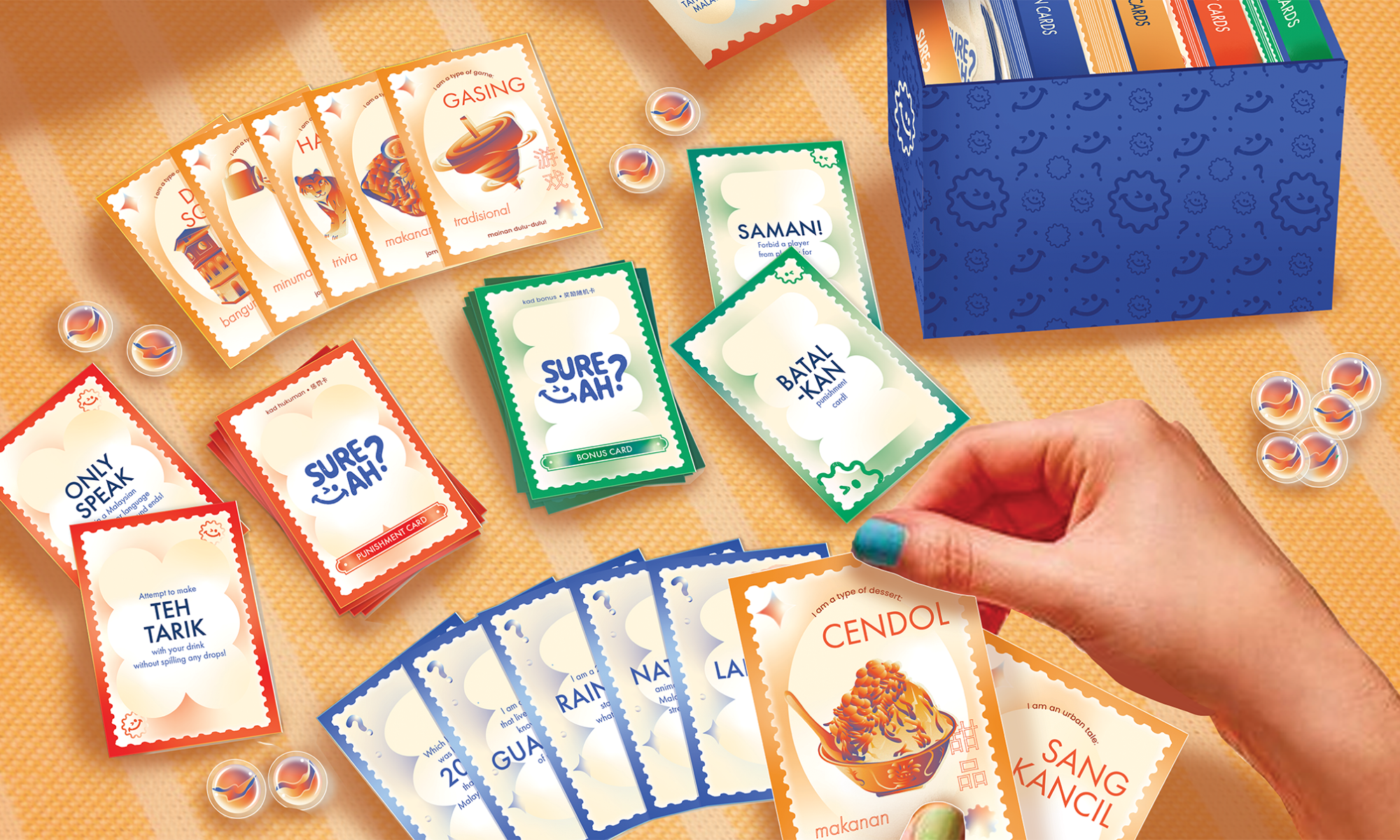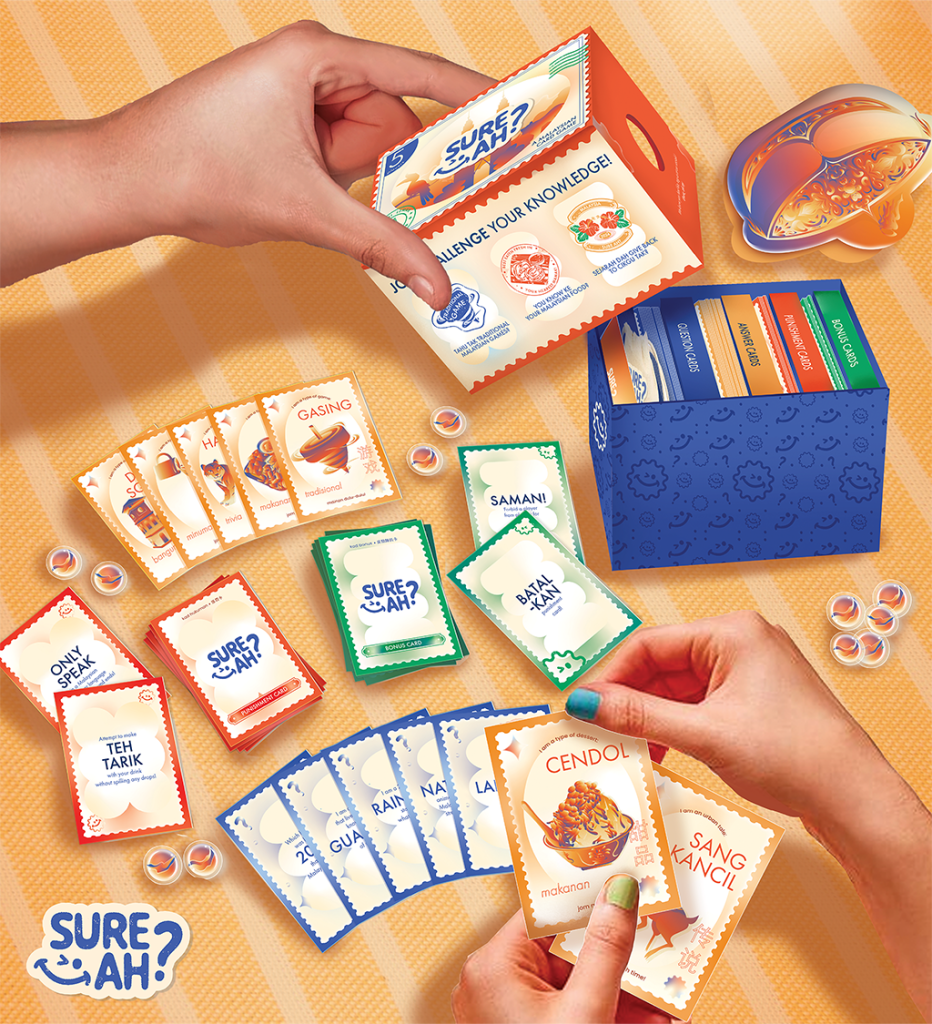
Sure Ah? is a Malaysian themed card game I designed for my final year project at Taylor’s University that challenges players to test their knowledge of Malaysia. Through gameplay, the project aims to minimise the reliance on phones by focusing on more genuine connections. Hence, addressing the growing issue of mobile phones that undermine opportunities to connect with people. This project was designed as a way to boost interest and knowledge of Malaysia in a fun and engaging way and to encourage meaningful conversations where players can have fun guessing the answers and also laugh about them.
The inspiration for this project came to me while playing card games with friends during our gatherings. Games like “Happy Family” and “The Malaysian Dream” sparked the idea to create a card game with a similar framework—one that not only strengthens relationships but also rekindles interest in Malaysia.
Conversations with my foreign friends led to the inclusion of Malaysian slang in the game to add a distinct Malaysian flair. Sure Ah? is designed to encapsulate the essence of Malaysia as a whole. To further convey this concept, I chose a brand name in Manglish (Malaysian English), Sure Ah—a phrase used by Malaysians almost daily, or at least by those around me. The brand name is a playful way to express the fun and mischievous spirit the brand aims to convey.
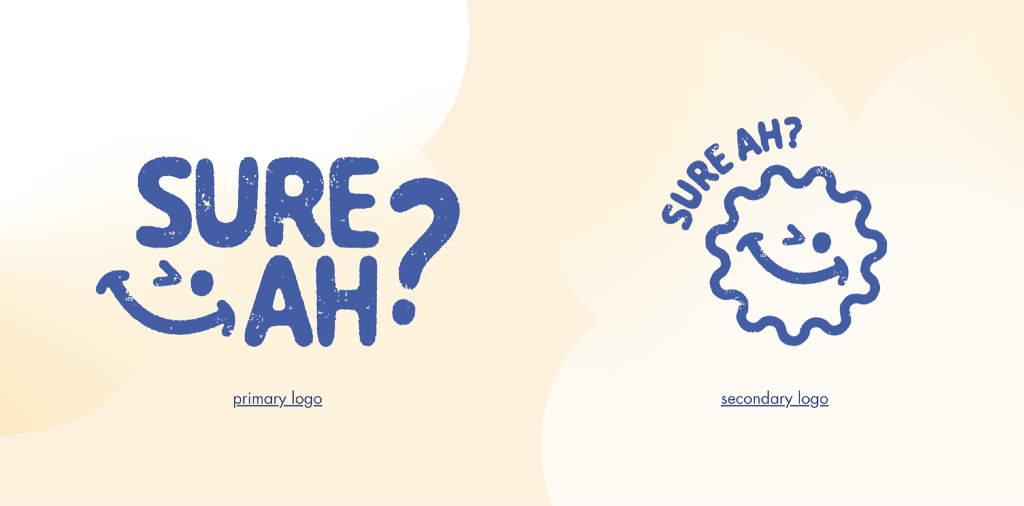
The primary logo is a word mark, while the secondary logo is a logo mark that channels a fun, retro vibe with a stamping effect further highlighting the brand’s mischievous and cheeky character that challenges players to test themselves.
Sure Ah challenges players in three categories: Jom Makan Lah, all about Malaysian food; Mainan Dulu-dulu, traditional games that bring back memories; and Sejarah Time, which puts players’ knowledge to the test! Items chosen to be included in the card games are things we can often find in our daily lives such as in the kopitiam and mamaks around Kuala Lumpur, in our grandparent’s houses and old sundry shops.
I thoughtfully chose items that best represent Malaysia such as the rafflesia flower, the congkak, and nasi lemak. Each answer card was designed to resemble a stamp, complete with a bordered edge to capture the look and feel of an actual stamp. I drew real-life inspiration from visits to Pasar Seni, particularly Central Market and bookshops, to ensure accuracy in my work.
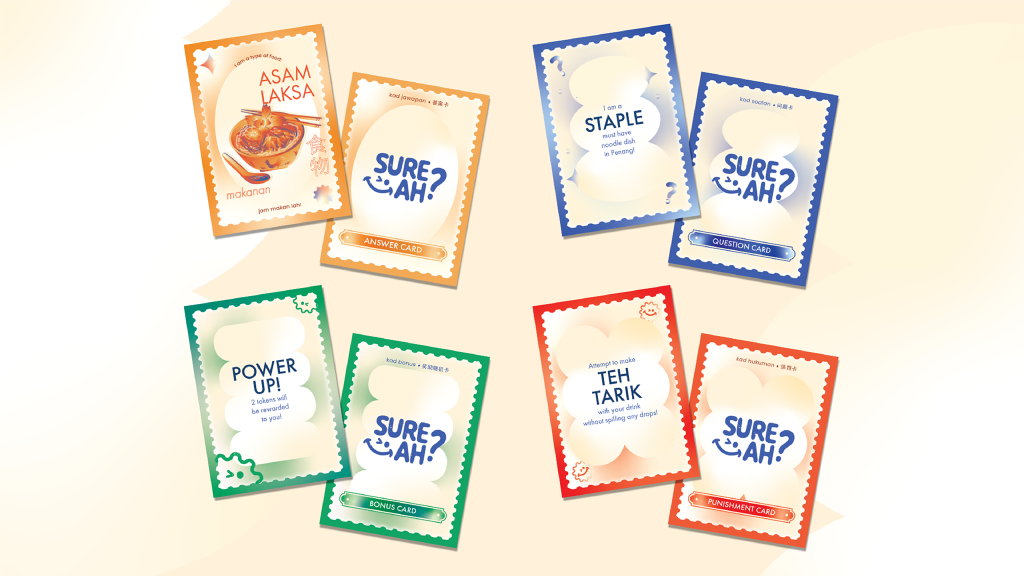
The card game consists of 60 cards divided into four decks: Question Cards (22), Answer Cards (22), Bonus Cards (8), and Punishment Cards (8). The game is intended for four players and one moderator, known as the Ketua Pengawas. The moderator, or Ketua Pengawas, must familiarise themselves with the answers to effectively perform their role. The rules are fairly simple, whoever pairs the answer and question cards the fastest will receive a token, and the player with the most tokens wins.
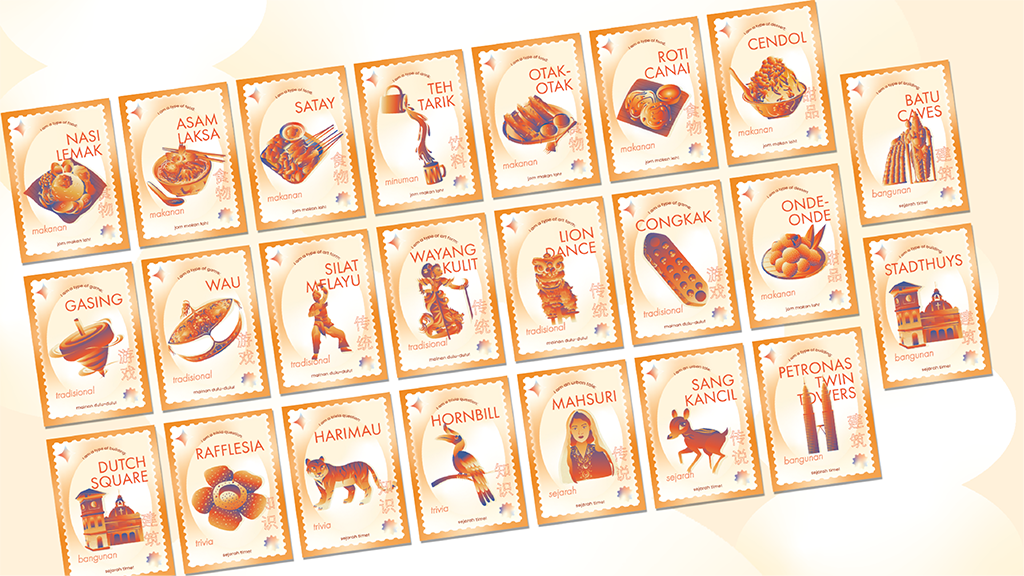
First, the moderator shuffles the 22 Answer Cards and lays them on the table, the illustration side of the cards facing upwards so all the players can see what they are. The moderator will then shuffle and pick a Question Card to read aloud. The fastest player to react to the question picks an Answer Card. Once answered correctly, the player earns a guli token and the chance to pick a bonus card from the Ketua Pengawas. When answered incorrectly, the player chooses a punishment card and has to carry out the punishment.
There’s a twist! In the bonus card deck, there are special cards like Jangan Attack and Batalkan Punishment that players keep. These cards can be used when a player answers incorrectly and is required to perform a punishment. Both the bonus and punishment cards are reused throughout the game. The game continues until all Answer Cards and Question Cards are paired together. The player with the most guli tokens wins the Student Terbaik reward tag, while the player with the fewest gets the Macam Yes Tapi Bukan joke tag. The key here is that though the player might have lost in one round, they receive the tag as encouragement to do better!
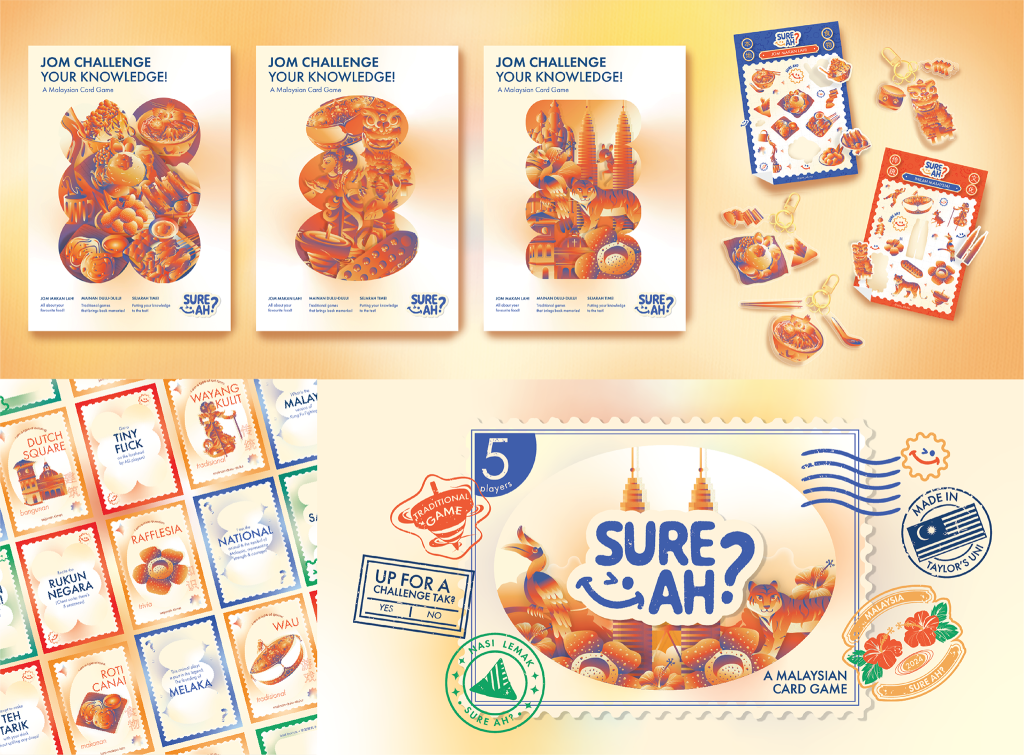
As part of the experience, I created a Kit Set featuring exclusive Sure Ah merchandise, including sticker sheets, keychains, and a tote bag. To enhance the local flavour, I drew inspiration from kopitiam (coffee shop) signs to include in the sticker sheets. My favourite piece to create was the keychain set, which includes three different illustrations in one keychain. The tote bag design is inspired by a postcard, adorned with stamping elements from the three categories and the logo to evoke a retro, nostalgic vibe.

Before beginning the design process, I knew I wanted to create a brochure that stood out from the ordinary. To achieve this, I incorporated a window element that gives people a sneak peek inside the brochure. The shape of the cutout window was inspired by the secondary logo’s design. The brochure provides an overview of what’s included in the kit version and features a QR code to access Sure Ah’s social media page. To channel my passion for animation, I create animated GIFs for Sure Ah’s? social media pages, bringing the still poster illustrations to life. This also serves as a way to showcase my versatility as a multi-disciplinary designer.
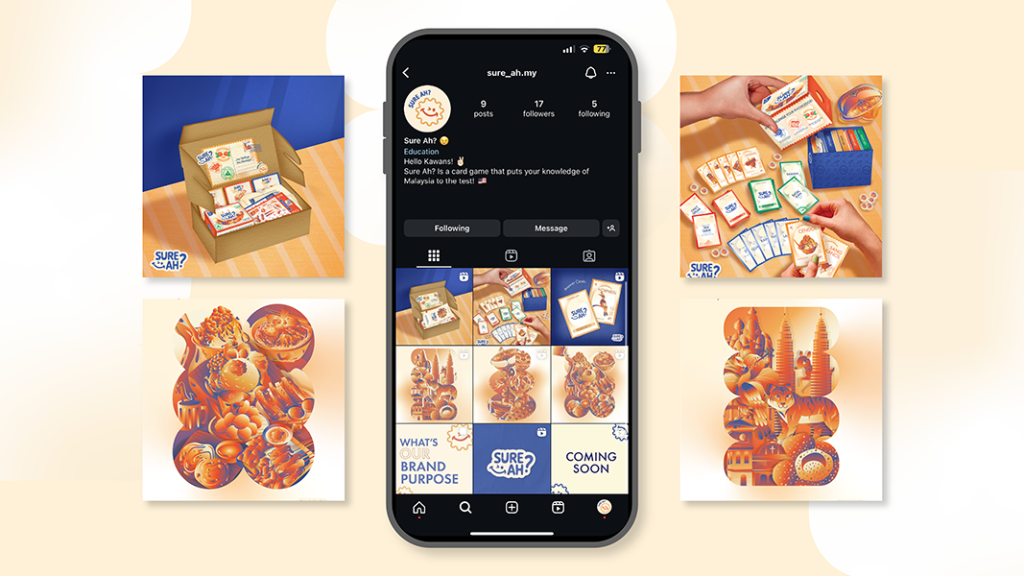
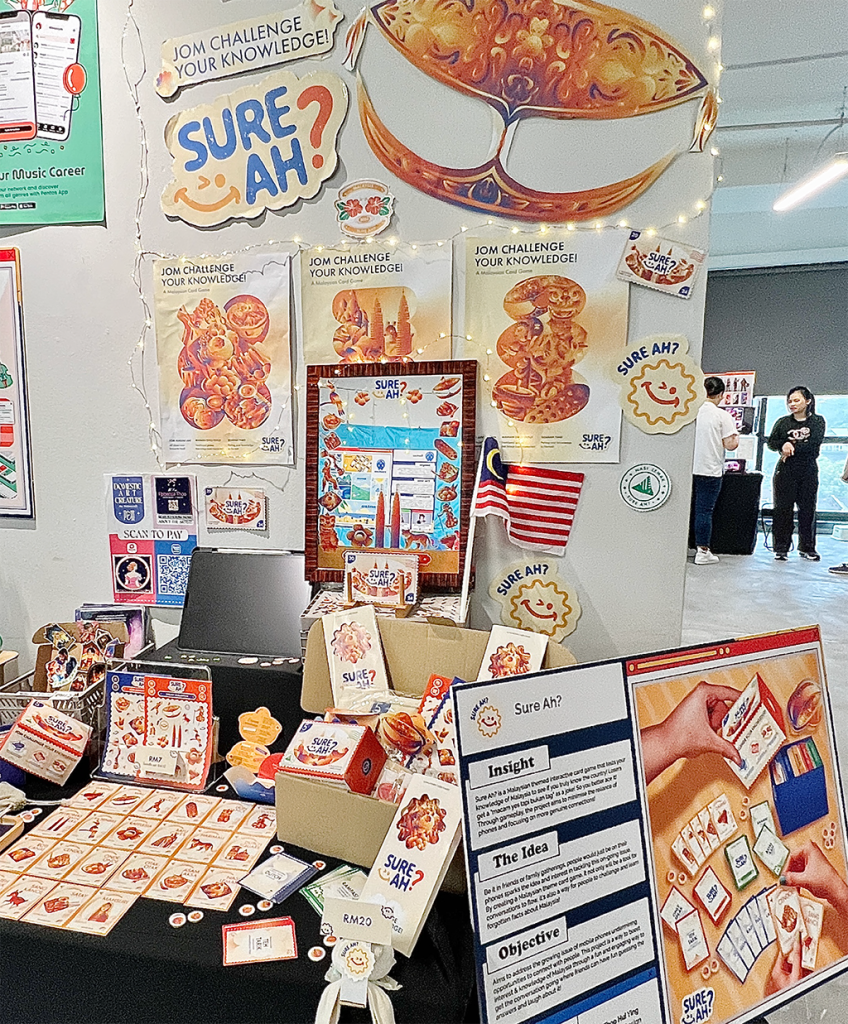
I participated in the ’24 Interlude Exhibition where we showcased our graduation projects at Ken Gallery in TTDI. Setting up was an exciting experience as I finally saw my vision come to life. Sure Ah? became a popular stop for visitors, thanks to the large Wau cardboard and Jalur Gemilang flag I displayed, and the fact that almost all of the wall was covered with cardboard cutouts of elements in Sure Ah?. The booth installation drew in a lot of attention, and I received overwhelmingly positive feedback from those who visited.
The engagement with Sure Ah? was high, and I was thrilled that people stayed to ask questions and learn more about my project. Many were surprised when I shared that I had created the project with Merdeka Day and Malaysia Day in mind four months ago although the showcase would be in early August. Visitors showed great enthusiasm for the project and loved playing the game with me.
One of the most challenging aspects of the project was the packaging design, but it was also where I learned the most. I went through numerous trials to achieve the best result, spending a lot of time in the library printing and figuring out the perfect dimensions to fit the cards and how to make the inlays in the bottom box look seamless. In the end, the results were worth it! Booth visitors remarked that the card packaging was so well-designed that it looked like something you would find commercially.
I also achieved my main goal, which was to have friends play the game, test their knowledge, and laugh at each other’s incorrect answers. The game brought plenty of laughter, bright smiles, and shocked incredulous expressions—especially from those who answered incorrectly.
“Oh, this is kind of like the UNO nope card, right?” was a comment I received when showing the jangan attack and batalkan punishment cards from the bonus deck. Booth visitors that drew inspiration from familiar card games, and incorporated those ideas into Sure Ah? which proved to be a smart move.
I let them choose their own Punishment Cards to fully immerse themselves in the card game experience. They even tried out the punishments and were impressed by what I had prepared. The punishments are a Malaysian twist on the classic truth or dare concept. Some cards bring a touch of embarrassment such as “Shout Malaysia Boleh as loud as you can” card, while others challenge them to think, such as the “recite the Rukun Negara” card. There are also straightforward dares such as “attempt to make Teh Tarik with your drink” card.
As players engaged with the game set, I felt a deep sense of joy and accomplishment since they genuinely loved it. They also praised the questions for being witty, cheeky, and informative—exactly what I aimed to create. Hearing all the wonderful feedback made the late nights spent debating what to write and doing research feel entirely worth it. The most frequent questions I received were, “So, are you selling the game set?” and “Oh man, I’m here to buy the game set.” I could only smile and answer that maybe in the future they will see it in stores.
We as Malaysians who grew up in Malaysia might be familiar with most of the items we see illustrated on the answer cards but do we truly know the facts behind each of the items? I not only feel a sense of pride that my last project as a uni student was to create a game that educates players about Malaysia and but also a sense of relief once the project was completed.
One last question, do you truly know the origins of the animal that plays a part in the legend, the founding of Melaka? Only one way to find out — I challenge your knowledge!

